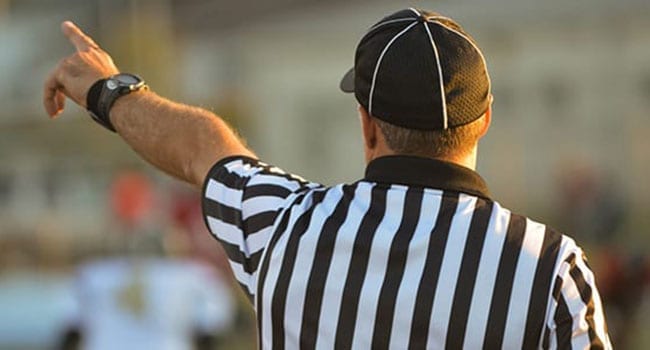 It’s Game Three of the 2019 World Series and the Washington Nationals hope to extend their surprising 2-0 lead in games over Houston. The Nats have revival project Anibal Sanchez on the mound to give Washington fans their first home-field win in a Series since 1933.
It’s Game Three of the 2019 World Series and the Washington Nationals hope to extend their surprising 2-0 lead in games over Houston. The Nats have revival project Anibal Sanchez on the mound to give Washington fans their first home-field win in a Series since 1933.
But the Astros are off to a quick lead. In the third inning, they’re up 1-0 on the Nationals and Sanchez is trying to get past the heart of the Astros’ batting order. With José Altuve on second, Sanchez is trying to paint the corners against Michael Brantley. With up to nine different pitches at his command when he’s on, Sanchez is a master at dotting the ball.
But umpire Gary Cederstrom is having none of it. While TV’s virtual strike zone shows Sanchez catching the zone on consecutive pitches, Cederstrom calls them balls. Sanchez is visibly perplexed. He walks partway down the mound to query Cederstrom – as if it will make any difference.
Sure enough, Brantley squibs a single off Sanchez to score Altuvé and the Astros jump into a 2-0 lead – a lead they won’t surrender all night on the way to getting their first win in the Series.
(The Nats were stung again in Game Five when a pitch that was clearly a ball was called a strike, nipping a Washington rally in the bud.)
All of this begs the question: If Major League Baseball’s TV partners have the virtual strike zone, why are the game’s leaders still allowing a human eye to call balls and strikes?
Traditionalists – and the umpires union – lose their minds over going high tech. As a former MLB catcher once told me, the cameras (located in centre field) can be shaken if the crowd is too rowdy in the stands. Except that the virtual strike zone is created by laser.
If the virtual strike zone seems arbitrary, taking away the best umpires, it does eliminate the worst ball/strike umpires.
MLB has done much to improve the calling of balls and strikes in the past decade, but it can’t replace the unflinching standard of modern tech. Like the Hawk-Eye technology that rendered tennis line-call disputes as dated as John McEnroe’s tight shorts, a virtual strike zone will end bitching about the strike zone.
Who are you going to argue with? A computer? The lasers that shoot the zone?
This is not just a matter of being correct, it’s also about consistency (see this CBC News feature on how developed the laser-based tech has become).
But MLB has nothing on the National Football League when it comes to Luddite choices. Have you ever noticed those fat guys in the construction worker vests on the sideline holding a chain and poles? The ones who get run over like road kill when the running back goes out of bounds?
The chain gang is there to apply 14th-century metrics in the 21st century. Their appointed rounds involve stretching said chain to the full glory of its 10-yard length – without tripping players as they traverse the field. Among my favourite chain moments occurs when the chubby guys ‘sprint’ to get the chain apparatus set up on the 25-yard line after a touchback on a kickoff. We know that the next first down can only be made by getting to the 35 yard line, yet the Einsteins of the NFL are befuddled by the notion of any part of the ball touching the 35-yard line will show … a first down!
So we need a chain gang and an officious ref to hold up play while they fiddle with a chain you can buy for $7.50 at a hardware store?
We know that somewhere in the tech world is someone who could tell the NFL (plus Canadian Football League and American college football) how to measure for a first down using something other than a kit bought on the way to the park.
Even soccer – the ultimate 19th century game – has figured out a way to use tech to determine if the ball is completely across the goal line. In football, they must unpack a posse of 300-pounders from the goal line before they can eyeball a touchdown. When that fails, they go to camera angles with the referee playing Galileo.
Hockey still favours the eye test on goals, too, relying on TV camera angles to determine a good goal. Hello, chip in the puck?
But when it comes to the science of sport, the National Hockey League’s unique contribution is medical, not technical. In this era of high-tech health care, the NHL harkens back to the apply-a-leech traditions of medieval medicine.
When a player is carved by an opponent’s stick above the shoulders, it calls for an automatic two-minute penalty. Ah, but there can be a more severe penalty. How? If the player is bleeding from the wound. So we have the kabuki of a referee, who’s challenged to apply a bandage to his own boo-boos, casting a Hippocratic eye on a player’s cut.
What if there’s no blood but a bone is sticking out? What if the offending stick has removed teeth without a commensurate river of blood? Who knows?
The referee has only first-aid knowledge fit for a Civil War battlefield. The standard is blood gushing from the wound and that’s that.
Will all this change?
Just remember that sports has always been a traditional enclave where progress is just a word in the dictionary between pigheaded and protest.
Troy Media columnist Bruce Dowbiggin career includes successful stints in television, radio and print. A two-time winner of the Gemini Award as Canada’s top television sports broadcaster, he is also the publisher of Not The Public Broadcaster.
The views, opinions and positions expressed by columnists and contributors are the author’s alone. They do not inherently or expressly reflect the views, opinions and/or positions of our publication.


